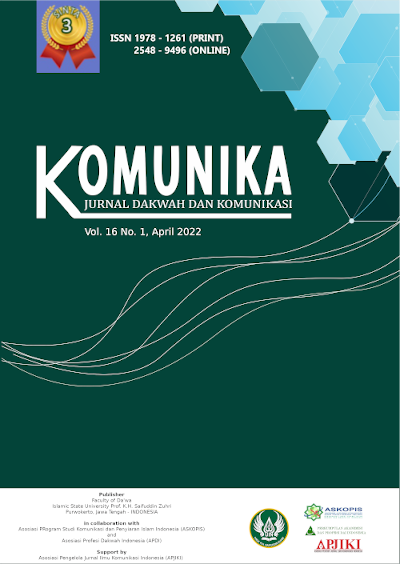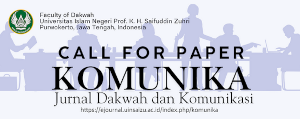Digital Literacy Vs Flexing Culture on Youtube
DOI:
https://doi.org/10.24090/komunika.v16i1.7432Keywords:
Flexing, popular culture, digital literacy, YouTubeAbstract
This research aims to analyze how flexing can become a popular culture in Indonesia. This research analyzes the flexing phenomenon on YouTube social media for some Indonesian content creators. How can YouTube become a mechanism for spreading and flexing popular culture, and how is it related to digital literacy? This study used a qualitative method with a phenomenological approach and data collection through literature study and interviews. The Ecumenical Culture and Invasion diffusion theory is used as a theoretical framework. The results of the research stated that when it comes to Indonesian digital literacy, numerous people take the information hypocritically and are deceived by the lifestyle of influencers and try to follow the influencer's lifestyle. People who do not have an adequate understanding of digital literacy tend to believe what they see more easily. Listen and read regardless of their level of education and generate a desire to own things that are seen on the YouTube content watched. At the same time, people who know about digital literacy will tend to be more selective in finding and absorbing information.Downloads
References
Fadli, Rizal M. (2021). Memahami Desain Metode Penelitian Kualitatif. Universitas Negeri Yogyakarta. Jurnal Humanika Vol. 21(1) pp 35-54.
Fitriani,Inda. (2012). Pembentukan Budaya Populer Dalam Kemasan Media Komunikasi Massa. Universitas Islam Sultan Agung Semarang. Jurnal Ilmiah Komunikasi Makna Vol.2 No.2
Gallois, Cynthia. Shuan, Liu. (2015). Introducing Intercultural Communication, Global Cultures and Contexts. SAGE Publication
Hamid, Farid. (2012). Media Dan Budaya Populer. Jurnal komunika vol 15 issue 1
Juha, Park. Jaehoon,Chun. (2021). The Characteristic Of Fashion Flex On Social Media. Seoul National University. Fashion and text Res.Journal vol.23 No.1 pp 31-43
Kemenkeu.go.id (2022). “Crazy Rich, Flexing dan Budaya Ketimuran”. Accessed: May 12, 2022 at https://www.djkn.kemenkeu.go.id/kpknl-kisaran/baca-artikel/14817/Crazy-Rich-Flexing-dan-Melunturnya-Budaya-Ketimuran.html
Kompas (2022). “Apa itu Flexing? Ramai disebut di Media Sosial dan Apa Tujuannya?” Accessed: May 9, 2022 pada https://www.kompas.com/tren/read/2022/02/15/130000765/apa-itu-flexing-ramai-disebut-di-media-sosial-dan-apa-tujuannya-?
Mahyudin. (2017). Social Climber Dan Budaya Pamer: Paradoks Gaya Hidup Masyarakat Kontemporer. Universitas Gajah Mada. Jurnal kajian islam Interdisipliner vol 2 nomor 2 Juli-desember 2017
Mufid, Muhamad. (2005). Komunikasi dan Regulasi Penyiaran. Jakarta. Prenada Media Group.
Setiawan, Rudy. (2013). Kekuatan New Media dalam membentuk budaya popular di Indonesia (Studi tentang menjadi artis dadakandalam mengunggah video music di youtube). Ejournal Ilmu Komunikasi vol.1. no.2
Sudarma ,Momon. (2014). Antropologi Untuk Komunikasi. Jakarta. Mitra Wacana Media.

Downloads
Published
Issue
Section
License
Copyright (c) 2022 Risnawati, Muhammad Farid

This work is licensed under a Creative Commons Attribution-ShareAlike 4.0 International License.
Authors who publish with this journal agree to the following terms:
- Authors retain copyright and grant the journal right of first publication with the work simultaneously licensed under a Creative Commons Attribution-ShareAlike 4.0 International License that allows others to share the work with an acknowledgement of the work's authorship and initial publication in this journal.
- Authors are able to enter into separate, additional contractual arrangements for the non-exclusive distribution of the journal's published version of the work (e.g., post it to an institutional repository or publish it in a book), with an acknowledgement of its initial publication in this journal.
- Authors are permitted and encouraged to post their work online (e.g., in institutional repositories or on their website) prior to and during the submission process, as it can lead to productive exchanges, as well as earlier and greater citation of published work (See The Effect of Open Access).
























